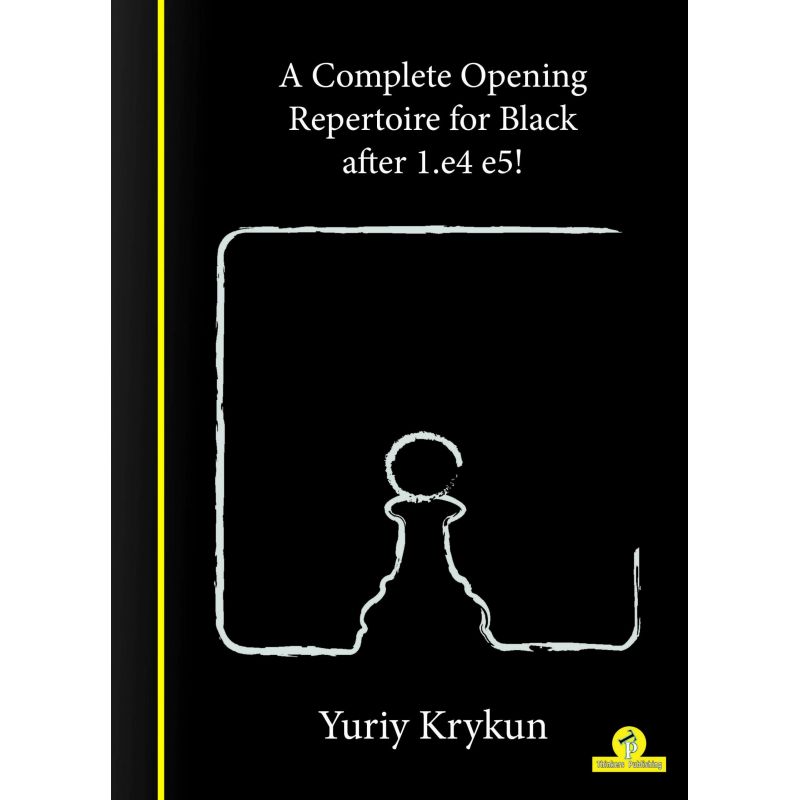Szachy dla trzech graczy / Szachy dla 3 graczy Duże ( S-62 )
Szachy drewniane
Wymiary: 270 x 470 x 50 mm
Król: 85 mm
Waga: 1,1 kg
Szachy drewniane
Wymiary: 270 x 470 x 50 mm
Król: 85 mm
Waga: 1,1 kg
SZACHY TURNIEJOWE NR 5 - CZEREŚNIOWE
Drewniane figury Staunton nr 5 z drewna czereśniowego - obciążone, podklejone zielonym filcem
- Wysokość króla - ok. 90 mm;
- Wysokość pionka - ok. 45 mm
Szachownica drewniana, składana na pół z miejscem na figury w środku.
- Wymiar szachownicy: 48 x 48 x 2,7 cm;
- Wymiar pola szachowego: 48 x 48 mm;
Waga łączna: 1.7 kg;
Drugie wydanie pierwszej części wspaniałej książki autorstwa czelabińskiego arcymistrza i wybitnego trenera. Pozycja ta jest wyśmienitym podręcznikiem końcówek szachowych. Autor prezentuje przede wszystkim metody i nawyki gry w końcówkach.
Szachownica i figury wykonane są z drewna.
Wymiary: 420 x 210 x 50 mm
Król: 78 mm
Waga 1.60 kg
 Nowy elektroniczny zegar szachowy LEAP KK9908
Nowy elektroniczny zegar szachowy LEAP KK9908
Charakterystyka zegara:
• zegar z atestem FIDE!
• opcja dodawania czasu
• 37 ustawień zegara dla szachów oraz różnych gier
• maksymalna prostota obsługi
• duży, czytelny wyświetlacz pozwala na odczytanie czasu nawet z odległości 10m!
waga: 0,2 kg
Kompletny zestaw dwóch części książki Mistrzowie Polski w Szachach obejmujący biografie polskich szachistów grających w latach 1926 - 2021r.
Produkt dostępny wyłącznie w formie pobrania
Nowe książeczki ChessBase zawierają kod aktywacyjny, który umożliwia pobranie produktu. ChessBase 18 oraz nowe bazy danych nie będą już wydawane na DVD-ROM. Szczegóły na końcu opisu.
ChessBase to samodzielna baza danych szachowych, która stała się światowym standardem. Korzystają z niej wszyscy – od mistrzów świata po amatorów. Jest to ulubiony program każdego miłośnika szachów, który chce poszerzyć swoją wiedzę i umiejętności. Rozpocznij swoją osobistą przygodę z sukcesami dzięki ChessBase i ciesz się grą jeszcze bardziej.
Puchary drewniane w kształcie figur szachowych w dwóch kolorach. Król, wysokość 35 cm, średnica podstawy 13 cm, wysokość podstawy 2,9 cm, waga: 0,7 kg
Puchary są idealne na nagrody dla dzieci w turniejach szachowych.
Podana cena dotyczy jednej sztuki.
Firma CAISSA jest producentem szachowych pucharów drewnianych.
Istnieje możliwość hurtowego zakupu niniejszych pucharów.
W sprawie zakupu hurtowego prosimy o kontakt mailowy: juzez@go2.pl lub telefoniczny: 509 983 593
Autor przygotował materiał, który zawiera propozycje gry wariantów przeciwko debiutom otwartym i półotwartym. Każdemu debiutowi autor poświęcił tyle miejsca, na ile zasługuje ze względu na bogactwo wariantów i częstość jego występowania w praktyce turniejowej.
Szachownica i figury wykonane są z drewna.
Wymiary: 420 x 210 x 50 mm
Król: 78 mm
Waga 1.60 kg
Kompletna edycja książek z serii WESOŁE SZACHY wydana w jednym podręczniku.
Ten kompleksowy podręcznik dla najmłodszych szachistów zawiera nie tylko wszystkie 3 części "Wesołych Szachów, ale także część 4 - czyli całkowitą nowość, dotychczas nigdy nie wydaną!
Nie możesz się zdecydować co podarować bliskiej Ci osobie na prezent? Szachy? A może lepiej warcaby?
A może sam chciałbyś mieć w domu jedno i drugie?
Dzięki niniejszemu zestawowi 2 w 1 masz możliwość cieszyć się obiema grami.
W drewnianej, składanej na pół, "wypalanej" szachownicy znajdziesz zarówno figury szachowe jak i bierki warcabowe.
Wymiary szachownicy po rozłożeniu: 35x35 cm
Wymiary szachownicy po złożeniu: 35x17,5cm
Wymiary pola 3x3 cm
Wysokość króla: 65 mm
Zestaw jest nie tylko przydatny i uniwersalny ale także bardzo poręczny.
UWAGA! Pionki warcabowe nie są podklejone filcem.
Kieszonkowe Szachy Magnetyczne w NOWEJ ODSŁONIE 2.0
Tym razem – składane na 3, dzięki czemu zyskały miejsce na "zbite" figury.
Dodatkowo wprowadzono notację, której brak czasem krytykowano w poprzedniej edycji.
Poręczny towarzysz w podróży w Twojej kieszeni!
Od dziś możesz grać w szachy gdziekolwiek i kiedykolwiek zechcesz!
- Idealne do analizy partii!
- Szachy wykonane są z tworzywa sztucznego.
- Zewnętrzna strona zrobiona została z ekoskóry.
- Materiał: Vinyl, ekoskóra, plastik
Edycja LIMITOWANA jednego z najlepszych elektronicznych zegarów szachowych DGT 3000 została wydana z okazji 25-lecia firmy DGT.
Od wersji standardowej zegara różni go ekskluzywny wygląd - wygląda jak by był wykonany z drewna!
Pozostałe parametry nie zostały zmienione.
1400 Kombinacji matowych - Ryszard Czajkowski, Andrzej Nowicki
----------------------------------------------------------------------------
Niniejsza książka to unikalny zbiór 1400 diagramów z praktyki szachowej mistrzów i arcymistrzów z wielu krajów i różnych epok oraz własnych przykładów samych autorów.
Stopień trudności poszczególnych zadań jest na tyle zróżnicowany, by każdy szachista czerpał radość z ich rozwiązywania, niezależnie od swoich umiejętności. Tak więc w książce znajdziemy proste i bardziej skomplikowane przykłady taktyki szachowej, klasyczne końcówki, piękne kombinacje, które na zawsze przeszły do historii szachów, studia, etiudy i kompozycje szachowe oraz odzwierciedlenie zawartych w nich idei przeniesionych do praktyki turniejowej.
Czytelnik może poznać różnorodne sposoby matowania – od najprostszych jedno i dwuposunięciowych do mata w 262 (!!) posunięciach.
Breloki szachowe figury drewniane mix.
Niezwykle istotne jest zapoznanie się z dorobkiem twórczym mistrzów świata. Czego można się nauczyć od nich? Z całą pewnością bardzo wiele. Każdy z nich był bowiem najwybitniejszym graczem swoich czasów i na drodze do tytułu najsilniejszego zawodnika globu musiał pokonać elitę najlepszych z najlepszych oponentów w rozgrywkach eliminacyjnych i w końcu zwyciężyć w meczu finałowym! W tych trudnych i emocjonujących spotkaniach musiał wykorzystać wszystkie swoje umiejętności oraz wiedzę, aby rozłożyć na łopatki wielu znakomitych przeciwników!
Zestaw idealnie uzupełnia program nauczania "Edukacja przez Szachy w Szkole" (Książki Magdaleny Zielińskiej "Grajmy w szachy").
Seria książek ”Szkoła Taktyki Szachowej” to zestaw zeszytów ćwiczeniowych, które pozwolą krok po kroku, w systematyczny i uporządkowany sposób opanować umiejętności potrzebne każdemu początkującemu szachiście, takie jak: elementarne matowanie króla przeciwnika, zrozumienie sposobu działania wszystkich figur oraz współpracy pomiędzy nimi, a także podstawowe motywy taktyczne.
To kompleksowe narzędzie do nauki szachisty, aż do III kategorii!
Książki stanowią idealne uzupełnienie wszystkich dostępnych podręczników, m. in. Magdaleny Zielińskiej ”Grajmy w szachy”, uznanego, jako oficjalny podręcznik programu Edukacja przez Szachy w Szkole.
”Szkoła Taktyki Szachowej” ... krok po kroku ... to jedna z nielicznych pozycji na rynku, która została stworzona tak, aby nauka stała się jak najskuteczniejsza i nie przerodziła się w nużący obowiązek.
Zadania ułożone są w odpowiedni sposób, zachęcający do doskonalenia swoich umiejętności, liczba zadań w każdej z części została dobrana tak, aby młody szachista mógł wystarczająco przećwiczyć zdobyte umiejętności, a przy tym nie znudził się monotonnością tematyki.
Trzecia część została wzbogacona w opisy motywów kombinacyjnych, co sprawia, że stała się kompleksowym narzędziem do ich nauki - zarówno podręcznikiem jak i ćwiczeniami.
Pod każdym z zadań znajdują się miejsca na zapisanie znalezionych rozwiązań.
W celu uniemożliwienia podglądania przez młodych, ciekawskich szachistów, prawidłowe rozwiązania zostały ujęte w łatwej do wyjęcia wkładce w środku książki.
DGT 1002 to najprostszy z dostępnych na rynku zegarów szachowych z opcją "BONUS" (dodawanie czasu za wykonane posunięcie). Jest niezwykle łatwy w obsłudze i bardzo przyjemny w użyciu. Wystarczy nacisnąć + lub -, aby ustawić pożądany czas.
Ze względu na niewielki rozmiar zegara, można go postawić przy samej szachownicy nawet nawet na małej przestrzeni na stole.
Wymiary zegara:
• długość 155 mm,
• szerokość 42 mm,
• wysokość 60 mm.
DGT 1002 pracuje na tylko jednej baterii (dołączonej do zestawu).
Na zegar udzielana jest 2-letnia gwarancja.
Doskonały zegar w prostej formie, prosty w obsłudze z dużym, czytelnym wyświetlaczem - idealny dla każdego gracza.
Polecany dla szkół i klubów szachowych.
Najnowszy zegar renomowanej holenderskiej firmy DGT!
Zegar idealny dla szkół i klubów szachowych!
Zegar DGT 1001 ma duży, przejrzysty wyświetlacz ( 11,5 x 2 cm), jest prosty w obsłudze i klasyczny w swoim wyglądzie.
Największą jego zaletą jest jednak cena - dużo niższa niż cena większości dostępnych na rynku zegarów.
Możliwość różnych ustawień oprócz tempa gry z dodawaniem czasu.
Wymiary: 15,5 x 6 x 4 cm
Zegar zasilany jedną bateria ( paluszek AA). Bateria w komplecie.
Szachy drewniane, składane ze specjalna kasetką na figury.
Figury turniejowe Staunton nr 5, obciążone, podklejane filcem.
Szachownica intarsjowana naturalny mahoń
Wymiar szachownicy: 47 x 47 x 2,5 cm;
Wymiar pola szachowego: 48 x 48 mm;
Wysokość króla: 93 mm; pionek: 4,5 cm;
Waga łączna: 2,00 kg;
1.e4 e5 is not just an opening. It is repertoire that represents our game as a whole. It is something players of all styles will enjoy due to the countless possibilities 1…e5 provides. Hopefully, learning 1…e5 will also make you a better player. And, finally, I hope the book you are now holding in your hands will not only give you joy but illustrate a passion for chess with the variations presented in this work.
BRAK NA MAGAZYNIE - produkt może zostać sprowadzony "NA ZAMÓWIENIE"

Gwarancja zwrotu pieniędzy

Bezpieczne i szybkie dostawy

Bezpieczeństwo transakcji dzięki certyfikatowi SSL
One of the important issues players face – both relatively inexperienced ones at the beginning of their career as well as seasoned ones as they realize their chess craves change – is choosing an opening repertoire.
As a player and a coach, I have seen many approaches to this question, both remarkable and mistaken. Some players believe that the opening is something to ignore, that everything is decided in the middlegame. Others think that studying opening traps is what wins games.
Some tend to follow their favourite world-class player’s recommendations, while others like to sidestep well-known opening theory early on, preferring unpopular side-lines.
To me, opening choice is about all those decisions. I think that many openings are good; there are some dubious ones, but they can also yield formidable results overall or in specific situations if chosen and handled carefully.
I firmly believe that your opening repertoire should mostly be based on your playing style and other personal traits, such as memory and work ethic. It is important to evaluate yourself as well as your strengths and weaknesses properly in order to be able to build the right repertoire that would not only suit you well, but also improve your overall chess.
The little detail, though, is in the word “mostly”. Namely, I firmly believe that there are a few classical, rock-solid openings with an impeccable reputation, such as 1.e4 e5 as a response to 1.e4 or the Queen’s Gambit and Nimzo as an answer to 1.d4 that players of all styles and standards should try, no matter what their style is. This will enable players to learn, appreciate and practice some of the key chess values, such as the importance of space, lack of weaknesses, bad pieces, and comfortable development and so on – you name it.
Opis
Szczegóły produktu
Piąta część z serii Repertuar Arcymistrza 1.e4
A repertoire for Black providing all answers to White’s options.
Paced with exciting games, original ideas and analysis.
Thorough and up-to-date coverage of one of the most topical openings.
Positionally motivated lines, but none the less never forgetting the needed dynamics.
Aggressive ideas to tackle head-on white’s solid set-ups.
BRAK NA MAGAZYNIE - produkt może zostać sprowadzony "NA ZAMÓWIENIE"
Coach Christof has thoroughly revised and updated his 2018 best-selling chess opening manual. It covers everything you need to know when opening with 1.e4. You will get a complete White chess opening repertoire.
2-е издание, переработанное и дополненное, популярной монографии, которая посвящена одному из самых боевых современных дебютов – староиндийской защите.
BRAK NA MAGAZYNIE - produkt może zostać sprowadzony "NA ZAMÓWIENIE"
BRAK NA MAGAZYNIE - produkt może zostać sprowadzony "NA ZAMÓWIENIE"
Are you ready to shock your opponent on move 3?
The Reti Opening is a dynamic opening invented by Richard Reti more than a century ago. It has since been featured in the repertoires of countless grandmasters and world champions, including Magnus Carlsen, Hikaru Nakamura, Garry Kasparov, Tigran Petrosian, Vassily Smyslov, and many others.










